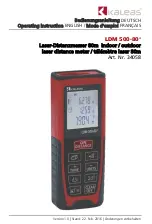
INSTALLATION
Ensure the unit is mounted on a vertical
surface. The multifunction lens shown on
page 3 produces 9 long and 9 short range
beam patterns. When positioning the unit
remember that movement across the beams
produces the best response whilst movement
directly towards the detector will be less
responsive.
During installation the electronics must be
protected against water, as trapped moisture
can effect or damage the unit.
1) First remove the front polythene cover
by pulling forwards, then remove the
lens module by pulling it out of the
forked bracket.
2) Drill the wall to accept the top fixing
and the lower cable entry. The holes
should be on 16mm centres.
3) Feed standard 4 core alarm cable into
lower cable entry; bare the wires and
connect to the removable terminal block.
4) Always ensure when replacing the
module that it is the correct way up for
the correct alignment of the beam
pattern. (page 3 multibeam lens data)
5) Replace the front cover with the
ventilation hole at the bottom. Ensure
the cover engages both sides of the outer
casing before pressing firmly to locate
it securely.
6) Apply the power - the red led flashes for
0.5 second.
- 2 -
At this stage the unit can be walk tested with
the front cover fitted. Adjust the range as
necessary and pan and tilt the lens module
over the field of view to obtain the correct
beam coverage and ensuring that the
detection beams do not exceed the area being
covered.
TESTING THE OUTPUTS
(Alignment of the detection beams)
The range of the detector increases without
the front cover. Therefore the cover must be
fitted during ‘walk test’.
Floodlights should be positioned at the side
or above the detector 60cm (2 feet) is
recommended, provided that the detector is
not in direct radiated head from the floodlight.
The unit detects the changes in heat and
movement in the beam pattern area, therefore
trees, shrubs, ponds, boiler flues and animals
should be considered when positioning the
detector. In poor environment utilise the
‘pulse count’ option on the GJD lighting
controllers.
LIGHT LEVEL:
The unit is set at ‘5’ lux. This is the light level
that the ‘S’ -ve output operates when detection
takes place. This is generally considered the
average light level at dusk. If the lux level dial
is turned to 24 hour - this would activate the
‘S’ output for one minute after last detection
irrespective of light level.
Increase the lux level if the ambient light
levels at night are higher than 5 lux.
view behind the lens
factory settings shown
-20T +55C
S
A
GJD
LIGHTING CONTROLLER
GJD OPAL XL
12V
6mA
10
35MTR
3LUX
24
HR
50
20
CDS
LED
DO NOT TOUCH
PYRO






















